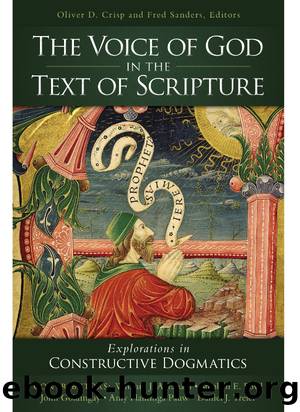The Voice of God in the Text of Scripture by Unknown

Author:Unknown
Language: eng
Format: epub
Publisher: Zondervan
Published: 2016-09-02T00:00:00+00:00
CHAPTER 6
PATHS BEYOND TRACING OUT: THE HERMENEUTICS OF METAPHOR AND THEOLOGICAL METHOD
ERIN M. HEIM
INTRODUCTION
As a biblical scholar writing for an audience of theologians, I am keenly aware of two things: (1) that Alan Torrance is right about how quickly and imperceptibly biblical scholars tend to move from second-order talk about God (the “god-talk talk” of historical inquiry) to first-order talk about God (the “God-talk” of theology),1 and (2) that I am a biblical scholar by training, and thus have probably been guilty of this. In fact, maybe this paper should have been titled “Paths beyond Tracing Out: A Biblical Scholar’s Circuitous Journey toward the Distant Land of Systematic Theology.” So, I do not presume to approach the question of metaphor and theological method as the biblical scholar “in-the-know” on a crusade to make those theologians pay attention to the historical minutiae of Scripture’s metaphors. On the contrary, my hope is to offer some humble observations on the relationship between the historical particularity of Scripture’s metaphors, situated as they are within texts with particular audiences, authors, and historical contexts, and theology’s “God-talk” of the first order.
According to Alan Torrance, Murray Rae, Samuel Adams, and others,2 biblical scholars often go about the interpretation of Scripture, and by extension Scripture’s metaphors, precisely backward, bracketing the question of God out of the historian’s task, beginning instead with an “objective” account of the historical data,3 and then imperceptibly adding God-talk of the first order (rather than god-talk talk) back into their conclusions. To honor and learn from their valid objections, I will approach the question of the historical particularity of Scripture’s metaphors and the correlated question of theological method by attempting to wear the hat of a theologian. In other words, I will operate from the assumption that theologians like Torrance, Rae, and Adams are essentially right about the relationship between history, Scripture, and theology,4 and I see my job as to situate within this framework an account of how God speaks through Scripture’s metaphors. In short, following Torrance, my point is that a responsible account of Scripture’s metaphors must be rooted in the assumption that Scripture is God’s self-revelation and requires the phronema tou pneumatos (mind of the Spirit) to be read aright. Within this framework, I will argue below that we must understand God as the Maker of Scripture’s metaphors,5 which were revealed within particular historical and cultural contexts, but through the Spirit continue to speak to the church as God’s people in every age. As a Metaphor-Maker (a term I will unpack below), God invites the audience of Scripture to enter into a “sameness of vision” and to share in the divine perspective presented in the text.
To build a bridge between Scripture’s metaphors and theological method, I must first lay a foundation that defines and defends the presence of metaphor in the texts of Scripture. In order to elucidate the relationship between Scripture’s metaphors and constructive theology, we must understand what metaphors are and how they work to create meaning for their readers/hearers.
Download
This site does not store any files on its server. We only index and link to content provided by other sites. Please contact the content providers to delete copyright contents if any and email us, we'll remove relevant links or contents immediately.
Twelve Days of Christmas by Debbie Macomber(3022)
The Kiss of Deception by Mary E. Pearson(2384)
ESV Study Bible by Crossway(2097)
Waking Up by Sam Harris(1958)
7-14 Days by Noah Waters(1734)
Holy Bible (NIV) by Zondervan(1716)
The Harvest: Taken by M.A. Church(1575)
21 (The List Series) by Rhonda James(1487)
The King James Study Bible by Thomas Nelson(1472)
Warrior of the Light by Paulo Coelho(1247)
King of Kings by Unknown(1232)
Savage (Apex Predator Book 2) by David Meyer(1214)
My Daily Catholic Bible, NABRE by Thigpen Edited by Dr. Paul(1208)
Bound by You(1190)
The Falls by Unknown(1141)
The Holy Bible by King James Version(1110)
Proverbs by Zondervan(1094)
Good with Words by Patrick Barry(1093)
Agradecimientos by(1085)
